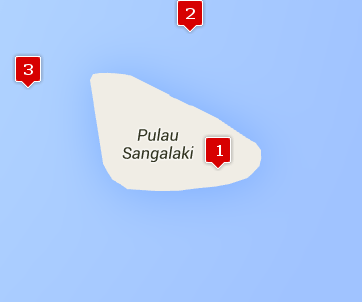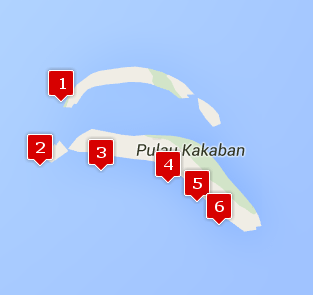GENERAL REPORT OF DIVING SITES IN MARATUA,KAKABAN AND SANKALAKI
ISLANDS. '
Date : 19th February — 3rd March, 2005
Between 19th February to 26th March, 2005, 36 exploratory dives on different sites of the above islands were made. These included the known points of “THE CHANNEL” near Mabucco Resort about 30 minutes away, the “BARRACUDA POINT” and the famous “JELLY FISH LAKE” in Kakaban island and the countless of manta at “MANTA POINT” in Sangkalaki Island .‘ As for the diving from the house reefs to the nearby areas wither 20_ minutes from the Maratua Paradise Resort, we have basically named a few point like the “CABBAGE COROL”, “THE TWIN PILLARS” and the “LIGHTHOUSE”. The rest we just called them the “HOUSE REEF S”. In total, we have explored 25 points to far, out, of which we have brought the first batch of Taiwanese divers to dive in 12 of the above points.
GENERAL DISCRIPTIONS OF EACH KNOWN POINT:
1. “MANTA POINT” AT SANGKALAKI ISLAND:
Perhaps this in the most excited point among all. The only thing when you dive at this point, you have to go when there in a high-tide. Otherwise, you ‘can only spot a few mantas under water. But on a high-tide, you can just loose count of the mantas on the surface, not to mention when you dive underwater from 5 meters to 15 meters. I can safely say, in one dive, you can easily spot about 30 to 50 mantas. Visibility: 20 to 25metres. Current: Mild.
2. “BARRACUDA POINT” AT KAKABAN ISLAND
This point is not for the beginner and those who have weak legs, because of the strong current there. Again, you have to dive this point during the high-tide. The dive begins with moderate current but as you go round the corner, the current become stronger. It is recommended that you bring along a hook so that you can station yourself to observe the schools of barracuda and jackfish, rainbow runners, batfish and if you are lucky, you may see hammerhead sharks as well. You can also find more than half a dozen of mini-pigmy seahorses in one sea-fan about the depth of 13 metres. Because this is a deep dive and the strong current, you can have a 30 or 35 minutes bottom time only. Visibility: 20 to 25 metres.
3. “THE CHANNEL” NEAR MABUCCO RESORT:
This is perhaps one of the strongest current point among all. A hook is strongly recommended as the current can easily blow you away. To dive in this particular point, you must go when the tide begins to come up. So you have to station yourself at the junction or entrance to the channel at about 30 meters . There you have to hold on to something or use your hook to hook on some solid rock so that you can hang in there to observe the most exciting fish feeding. There you can see many grey reef sharks and white tips, big school of barracuda and jackfish, also you can see giant groupers, schools of filsiliers, surgeant fish, rainbow runners and the biggest surprise to me was to find for the first time in my life , a big school of large size mullet fish. Again because of the depth you are staying to watch the action and the strong current, you have to let go after around 20 minutes and let the current drift you inside channel at a shallower depth and do your safety stop. Visibility: 15 to 20 metres.
4. “THE JELLYFISH LAKE” AT KAKABAN ISLAND:
The jellyfish lake is just 5 minutes away from the “Barracuda Point”. There are two trails to get to the lake, the first one was built with wooden planks all the way to the lake. It goes up a small hill and down all the way to the lake which will take you 10 to 15 minutes by walking. The second trail at the back of the lake is slightly longer. You have to climbs up a small lime store rock hill and then walk along a small jungle track which is going gradually downhill to the lake. In a glance, it is at least twice the size of the “Jellyfish Lake” in Palau, Micronesia. The visibility was about 6 to 8 meters and there are all together 4 different types of jellyfish. Whereas at the shallow bottom, you can see green fungus growing healthily.
5. THE “CABBAGE CORAL” REEF NEAR THE MARATUA PARADISE
RESORT:
This point is just 2 minutes from the resort among the house reefs. This is perhaps one of the most spectaculars sites that I have seen. This undamaged cabbage corals with the size of a football-field with the depth ranging from 5 metres to around 16 meters. As your go further out, the drop-off first go down to around 40 meters, then there in the next deep drop to more than 200 meters. On the first time when we check out this point two of my buddies saw 2 Mantas and a Eagle-Ray at around 30 meters deep. You can also spot a few turtles but the turtles here are very scared of divers. Each time you spotted one, it swam as fast to get away from you. Visibility: 20 to 30 metres. Current: Mild.
6. THE “TWIN PILLARS” OR “EAGLE RAY” POINT
This point as about 15 minutes from the Maratua resort. The story of these two pillars as told by the villagers who live nearby was the remains of a Japanese watch tower after it has been boomed during the Second World War. At this point, you can find perhaps the most varieties of Seafans and Black Corals. It begins at 45o down to about 30 - 40 meters, then the sharp, almost vertical drop-off to 70 meters. The barrel drum coral are huge. The Seafans began at around 25 meters up to around 40 meters and from 30 meters down, you will find plenty of huge Black Corals. We also called this point “Eagle-Ray” point, because every time we saw eagle-rays when we dived there. Visibility: 30 to 50 metres. Current: Moderate.
7. THE “LIGHTHOUSE” :
This point is about 20 minutes from the resort and is about 5 minutes from the “Twin Pillars”. Here the drop-off slopes gradually to around 40 meters where you will find the sandy bottom. The current here is mild and you can see a big school of batfish at around 30 meters, two times we saw a leopard-shark at around 30 meters. There at the shallow 5 to 6 meters of water, you can see a lot of grouper and red snappers around. Visibility: 30 to 40 meters.
8. “HOUSE REEF” JUST AROUND THE FRONT OF MARATUA RESORT
It’s best to dive at high tide because there current will be very slow. This is a good point to do early morning, sunset or night dive. You can see leaf fish, many kind of lionfish and crocodile fish. Ghost-pipe fish was said to be spotted by the resort dive master. Depth: 2 to 5 metres. Visibility: 20 metres.
9. “THE FIRST LAGOON”, ONE OF THE HOUSE REEFS
It’s just 100 meters from the resort and this point is good for night dives. It’s a long semi-circle lagoon-shape. It begins with a sandy bottom where you can find a lot blue spotted sting-rays and a lot round-jellyfish. As you go along, you will find beautiful staghorn corals along the bottom. Other thing you can see at night including stick pipefish, sea snake and big moray eels. Depth: 8 to 15 metres. Current: Mild.
10. “THE SECOND LAGOON”
It’s almost the same shape as the first lagoon which is next to each other. The only difference was that in this second lagoon, you find only beautiful Cabbage Corals and the depth range from 12 to 18 meters. This point is good for afternoon or sunset dives. I do not recommend for night dive is because there is not much activity at night here. During the day dive, you can see quite a few crab-eye gobby, nuddy branch, flatworm and other types of gobbies. Visibility: 15 to 20 metres. Current: Mild.
CONCLUSIONS:
I must say that during my 12 days stay at Maratua Paradise Resort have been exciting and enjoyable. The chalet are spacious and it’s fitted with air-conditioner. The shower room is 4m x 3m complete with bathtub and separate showers with hot water facility. The food at the resort is excellent and there is no lack of fresh water all year round.
Of all the sites or points that we have checked a lot of corals have been devastated by fish booming. Of course there are still so many nice and beautiful points are yet to be discovered and also there are so many points are yet to be named. In the near future, the micro heaven at Derawan Island will probably be included in the Maratua diving package because going to Derawan Island is less than an hour away. And with the boat transfer to and from Maratua to Tarakan or Berau will be more comfortable with the new 16-seater catamalan expecting to be ready soon. I can foresee that the diving in Maratua and the surrounding islands will become very popular for divers in the coming near future.
Prepared by:
Danny K.K. Chin
MSDT#54710,


